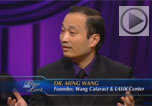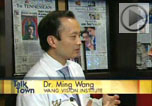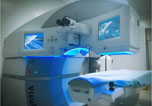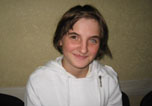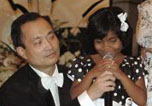- Over 55,000 LASIK and cataract procedures (including on over 4,000 doctors)
- The FIRST center in TN to offer Laser Cataract Surgery
- Introduced bladeless all-laser LASIK to the state
- Implanted the state's first FOREVER YOUNG™ Lens
- The first surgeons in the US to perform a new Intacs surgery to treat keratoconus
- Helped patients from 40 states and 55 countries
- International referral center for cataract surgery and LASIK complications
- Read Dr. Wang's book: LASIK Vision Correction
Why did you decide to have LASIK? Why did you choose Dr. Wang? How has your life changed since your LASIK procedure?
What is your advice for people considering LASIK?
Click to read more
| Home | Print This Page |
New Refractive and Corneal Surgeries of the 21st Century
By Ming Wang, MD, PhD, Wang Vision 3D Cataract and LASIK Center, Nashville, Tennessee
Published on July 20, 2006
The field of Ophthalmology has grown by leaps and bounds in the last ten years. New technologies and new techniques are allowing physicians to not only restore vision in damaged eyes, but also to improve the way we see with healthy eyes. Procedures like LASIK allow people to put their glasses and contacts on the shelf, and more and more refractive technologies are always being developed. At the same time, some of the blind are now seeing again, thanks to the increasingly successful application of new reconstructive eye surgeries such as amniotic membrane transplantation and stem cell grafts.
Here is a closer look at some of the most recent breakthroughs in refractive and corneal surgeries in the 21st century.
Amniotic Membrane Transplantation (AMT)
Researchers have discovered that a wound to a developing fetus can repair itself without a scar. Further investigation has revealed that the amniotic membrane, the thin membrane that surrounds the fetus in the womb, plays a key role in this “scar-less wound healing.” For many people, the presence or absence of scarring in the cornea means the difference between blindness and sight. Corneal specialists are now using amniotic membrane to cover damaged corneas, allowing the eye to repair itself with a reduced amount of scarring.
Stem Cell Transplants
One of the biggest buzzwords in medical research today is “stem cell.” In embryonic development, these undifferentiated cells divide and grow to become various tissues and organs. Once an individual is fully developed, stem cells play an important role in the body's defense and healing processes.
Adult stem cells can be transplanted, and in this regard, the field of ophthalmology has gone the furthest compared with almost all other branches of medicine today. When there is a traumatic event in the eye, stem cells are often completely destroyed, leaving the eye no way to heal itself. Doctors can now harvest a ring of stem cells from an adult donor and transplant them onto a damaged eye. Current stem cell researchers hope to find a way to utilize the stem cells from a patient's own body in order to eliminate the risk of rejection.
Wave-Front Technology for Refractive Surgery
Many refractive surgeons claim that this diagnostic tool will allow patients to undergo corrective surgery that could result in 20/10 “super-vision.” Still working its way through the very early stages of development, wave-front records higher level vision aberrations by shining a light into the back of the eye and recording the shape of the light wave as it is reflected back. The doctor can “see” these microscopic flaws in the eye's visual system by reading the wave pattern of the reflected light. The surgeon can then fine-tune the laser to precisely reshape the cornea for optimal vision, beyond the design of nature.
At the present time, wave-front technology may have some useful application in diagnostics and in improving our understanding of the visual system. However, wave-front technology still has a way to go before it becomes applicable to treatment, as it is limited by the uncertainties of biological wound healing after refractive surgery. Significant research is currently being conducted on the treatment of irregular corneal contours, particularly in post-refractive surgery patients. The goal is to create custom corneal treatments based on information gathered from lasers, corneal topography, and wave-front technology.
Experimental Presbyopic Surgical Treatments
Presbyopia, or “short-arm syndrome,” is an age-related loss of ability to see objects close to the eye. There are several new procedures in Phase I FDA clinical trials that aim to reduce presbyopia. In the meantime, the current solution is “monovision,” in which one eye is corrected for distance and one eye is corrected for reading. However, monovision is not for everyone; only 2 or 3 out of ten presbyopic patients are good monovision candidates. Unfortunately, presbyopic patients may have to wait years for these new presbyopic surgical procedures to be fully developed.
Phakic Intraocular Lens
Now in the late stages of FDA clinical trials, Intraocular Contact Lenses (ICLs) are being surgically implanted into the eye to correct extreme ranges in refractive error, while leaving the natural crystalline lens intact. ICL implantation is more invasive than LASIK, as it is an intraocular procedure that poses the risk of intraocular complications such as infection, retinal detachment, or cataract, but the cornea is not touched by these phakic IOLs. Their long-term effectiveness and safety is still under investigation. However, the general public will likely have access to this new technology by 2003 or 2004.
Adjustable Refractive Surgery (ARS)
This process involves two surgeries: the implantation of an intraocular lens followed by a subsequent LASIK enhancement procedure. First, a corneal flap is created, the intraocular lens is inserted, and the flap is replaced. Three to five months later, the second surgery, a LASIK enhancement to fine-tune the refractive errors, is performed.
Laser Thermal Keratoplasty (LTK)
Approved two years ago, LTK is a laser procedure that is designed to treat low hyperopia in patients over 40 years old. Unlike LASIK, the Hyperion LTK system involves a non-invasive surgery in which the curve of the cornea is made steeper with a holmium laser. LTK offers a “no-touch” feature, which is attractive to many patients. One of the down sides of the LTK healing process is prolonged postoperative myopia and visual fluctuation that lasts for several months. The FDA cautions patients that the effects of LTK are not permanent, and the eye's stability is also affected by the natural hyperopic shift in the early presbyopic age range.
Ming Wang, M.D., Ph.D., is an Associate Professor of Ophthalmology & Visual Sciences at Vanderbilt University, where he specializes in corneal and external disease. In addition, Dr. Wang serves as Director of Vanderbilt Laser Sight Center, and is a panel consultant for the FDA's Ophthalmic Device Panel.
For more information on the author, please visit www.wangvisioninstitute.com
Read More: New Refractive and Corneal Surgeries of the 21st Century
Our new texbooks
A 501c(3) charity that has helped patients from over 40 states in the US and 55 countries, with all sight restoration surgeries performed free-of-charge.



